
J. Arthur & Co. Acquires BrandCraft: Elevating Innovation and Market Expansion
J. Arthur & Co. is excited to announce the acquisition of BrandCraft, an award-winning creative agency celebrated for its expertise in brand strategy, digital marketing, and design. This strategic union blends J. Arthur’s AI-driven growth marketing, full-stack development capabilities, and data-backed strategic execution with BrandCraft’s creative excellence and brand leadership, forming an unmatched force in digital transformation.
With a shared commitment to client success, both J. Arthur & Co. and BrandCraft have built strong reputations for delivering measurable results through innovation, precision, and a client-first approach. This acquisition strengthens that mission—fusing technical expertise with bold creativity to help businesses thrive in an increasingly competitive digital landscape.
“BrandCraft brings industry-best creative talent that’s already collaborating well with our highly technical, client-focused team. The synergies between creative and tech will be impactful for our growing clientele.”
J. Arthur’s native AI platforms will serve as the foundation for company-wide AI enablement, driving efficiencies in predictive analytics, workflow automation, and intelligent data processing. This acquisition also strengthens J. Arthur’s entry as the provider of AI-as-a-Service and AI consultancy for middle-market and enterprise clients, ensuring businesses can leverage advanced AI solutions to optimize performance and scale growth.
BrandCraft has consistently set industry benchmarks for excellence, most recently winning 13 prestigious awards at the American Advertising Awards. These accolades underscore BrandCraft’s ability to deliver high-impact brand strategy, stunning creative campaigns, and performance-driven marketing solutions—all of which will now be complemented by J. Arthur’s strategic AI-driven approach.

This acquisition expands J. Arthur’s footprint across the Pacific Northwest, securing key markets in Washington, Idaho, and Oregon, while fueling further expansion along the West Coast. As part of this strategic growth, J. Arthur & Co. is adding offices in Boise, Idaho, and Richland, Washington, solidifying our regional presence and providing localized expertise to businesses in these emerging markets.
By integrating BrandCraft’s regional expertise with J. Arthur’s AI-powered growth strategies, this partnership creates unparalleled opportunities for businesses looking to harness the best of technology, strategy, and creativity.
With a shared vision for innovation, growth, and excellence, J. Arthur & Co. and BrandCraft together will reshape the future of digital services and continue pushing the boundaries of AI-driven marketing and creative impact.
Stay tuned as we evolve, innovate, and set new industry standards.
5 Proven Strategies to Skyrocket Your ROAS (Return on Ad Spend)According to Statista, 70% of all ad spend is primarily used on digital marketing. So, it is obvious that the world of digital marketing is becoming more competitive each passing day.
A proof of this competitiveness is that the average internet user is exposed to 98.5 ads per day, most of which aren’t actively perceived by the intended users. Each view that doesn’t generate a click means one lost opportunity.
Because brands are competing for the viewer’s time, businesses are constantly searching for ways to maximize their Return on Ad Spend (ROAS). This is the metric that tells you how much revenue your campaigns generate for every dollar spent.
With so many brands competing for attention, how can you boost your business’ ROAS without breaking the bank? The answer lies in smart, proven ad strategies. In this blog, let’s explore five proven tactics to help you skyrocket your ROAS and get the most out of your ad budget!
ROAS is a key performance indicator (KPI) that measures the effectiveness of your advertising campaigns. It shows how much revenue you’re earning for every dollar you spend on ads. For example, a ROAS of 5:1 means you’re generating 5 for every 1 spent.
This KPI also provides valuable insights regarding campaign performance. If used wisely, this KPI can be a key in choosing the best marketing channels and strategies.
Marketers are always on the lookout for strategies that deliver. Here are 5 strategies that are proven to be effective in improving your return on ad spend:
Your ad copy is the words that speak on your behalf. It needs to grab their attention and persuade them to take action.
Plus, a clear call-to-action (CTA) is a must-have too. CTAs like “Shop Now,” “Get Started,” or “Claim Your Discount” can encourage clicks.
Not every customer converts on their first visit. The marketing “Rule of 7” suggests that a potential customer needs to see an ad at least seven times before making a purchase decision. This is where remarketing plays a huge role in converting cold leads to warm leads and finally buyers.
Cold leads like website visitors or warm leads like those who have abandoned carts can be re-engaged with personalized ads. For instance, many e-commerce stores remarket those with abandoned carts by showing the same products they chose as ads. These leads are more likely to convert, making remarketing a powerful tool for boosting ROAS.
Another great idea is to conduct A/B testing of different versions of your ad copy, headlines, and CTAs. Testing will help you find the winning combination that drives conversions.
You could even try different colors, images, or audience segments to identify the most effective combinations.
There are a range of A/B testing tools available now that allow you to see which campaigns work effectively. Make sure that the results of your A/B tests are recorded so you can refine your campaigns over time rather than learning and relearning each time. A/B testing is a tool that shouldn’t be discredited, no matter how successful a brand might be.
Negative keywords are a simple yet effective way to optimize your ad spend. Irrelevant or low-intent keywords can target an audience that isn’t relevant to you. This means marketing bucks lost on a segment that is very unlikely to convert.
For instance, a luxury watch seller will add “cheap” or “affordable” as negative keywords to avoid attracting bargain hunters. This way, their ads are only shown to users who are more likely to purchase, improving the ROAS.
Your landing page is where the magic happens. If your ad and landing page aren’t aligned, you risk losing potential customers. To maximize conversions, create personalized landing pages that match the intent of your ads.
Here are three ways to optimize your landing pages:
Improving your ROAS isn’t just about spending more—it’s about spending smarter.
We’ve outlined proven strategies to maximize your paid ads investment. Take these tips, apply them to your campaigns, and watch your ROAS soar. The results will speak for themselves!
At J. Arthur & Co., we’re proud to drive excellent ads results for our clients and would love to help your business improve ROAS. Find out how we can get you the leads you’ve been waiting for: (401) 239-1311
In today’s rapidly evolving technological landscape, Artificial Intelligence (AI) has emerged as a game-changer for businesses of all sizes. While large corporations have been quick to adopt and benefit from AI, small and medium-sized businesses (SMBs) face unique challenges in implementing these cutting-edge technologies. Let’s explore the hurdles SMBs encounter on their AI journey and find solutions on overcoming them.
Before diving into the challenges, let’s look at some statistics that highlight the current state of AI adoption among SMBs:
– According to a survey by Vistage, 29.5% of respondents say they believe AI is among the technologies that will have the greatest impact on their business in the next year
– Global News Wire shares that the global AI market size is projected to grow from $58.3 billion in 2021 to $309.6 billion by 2026, with SMBs playing a crucial role in this expansion.
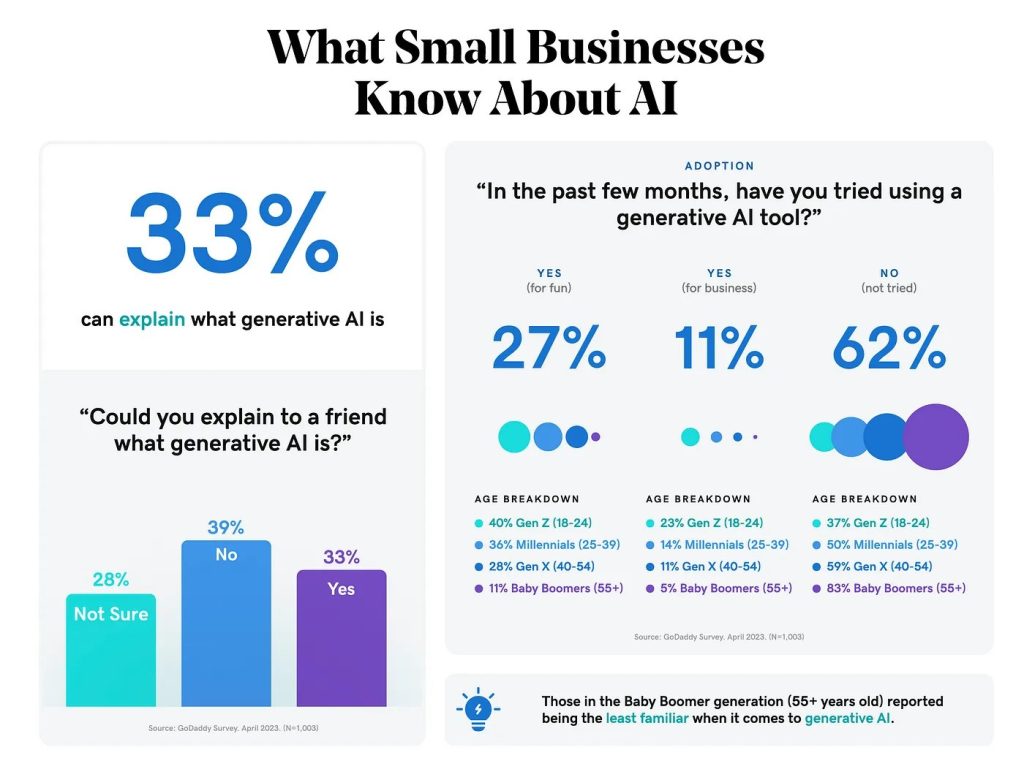
A study from Deloitte and Stanford University, found that 25% of small businesses are currently using AI in some form or another. With the use of AI in SMB’s increasing, the opportunities are arising. Machine learning enhancements, natural language processing, and computer vision, AI software is becoming more accessible for small business and in fact 72% of small business leaders believe that AI technology can offer a competitive advantage in the market. Although SMBs are gaining more access to AI, it comes with plenty of challenges that are stunting the exponential growth projections of AI in SMBs.
One of the most significant hurdles for SMBs in implementing AI is the perceived high cost and resource requirements.
The initial investment in AI is costly and can steer SMBs away, but considering the long-term benefits and potential ROI it may be a risk these businesses should be willing to take. Increasing efficiency and productivity in the workplace pays back over time.
Start small with pilot projects or consider AI-as-a-Service (AIaaS) solutions to minimize upfront costs.
Many SMBs struggle with implementing AI due to a shortage of in-house technical expertise. AI is new and complex and it takes someone with a good understanding of it to keep it running smoothly. Also for the benefit of the company, having an expert in-house can allow for the AI to be used to its full potential.
According to the U.S. Chamber of Commerce, 77% of small businesses cited either insufficient understanding of AI or uncertainty regarding its benefits as the main reasons for not integrating the technology into their operations.
SMBs can bridge this gap by investing in training programs for existing staff, partnering with AI consultants, or leveraging user-friendly AI platforms designed for non-technical users.
AI systems require large amounts of high-quality data to function effectively, which can be a challenge for SMBs with limited data collection and management practices.
SMBs should focus on improving their data collection and management practices. Start by identifying key data sources, implementing data governance policies, and leveraging cloud-based storage solutions for better data accessibility.
Integrating AI solutions with legacy systems and existing business processes can be complex and time-consuming for SMBs. SMB’s time is precious, and implementing AI could temporarily disrupt efficiency. Although once integrated, it will enhance capabilities and efficiency.
To overcome integration challenges, SMBs should conduct thorough assessments of their current systems, prioritize API-driven solutions, and consider working with AI vendors that offer seamless integration capabilities.
It’s estimated that small business owners spend Roughly 68 percent of their time on operational needs (day-to-day-management, overcoming problems etc.) and 32 percent of time working on growing the business.
Between the time needed to operate and grow a small company, creating time to research, invest and build AI tools is a significant hurdle for most operators.
The challenge becomes more difficult with businesses struggling to determine ROI of AI. In a recent Gartner survey of 700 IT leaders at organizations that have adopted or plan to adopt AI, 50% stated that AI’s value was in question.
Small businesses will find it hard to justify a large investment of time and staffing resources with returns being a moving target, choosing instead to allocate their time on operations and growth.
As AI becomes more prevalent, SMBs must navigate the complex landscape of ethical considerations and regulatory compliance.
Ascend2 partnered with Constant Contact and conducted a survey, surveying 486 small business owners and decision makers who work at U.S. organizations operating in both B2B and B2C. They found that 12% don’t think AI is ethical and 44% were concerned about their data. Along with other findings, it can be observed that people are not fully educated on AI and its purpose.
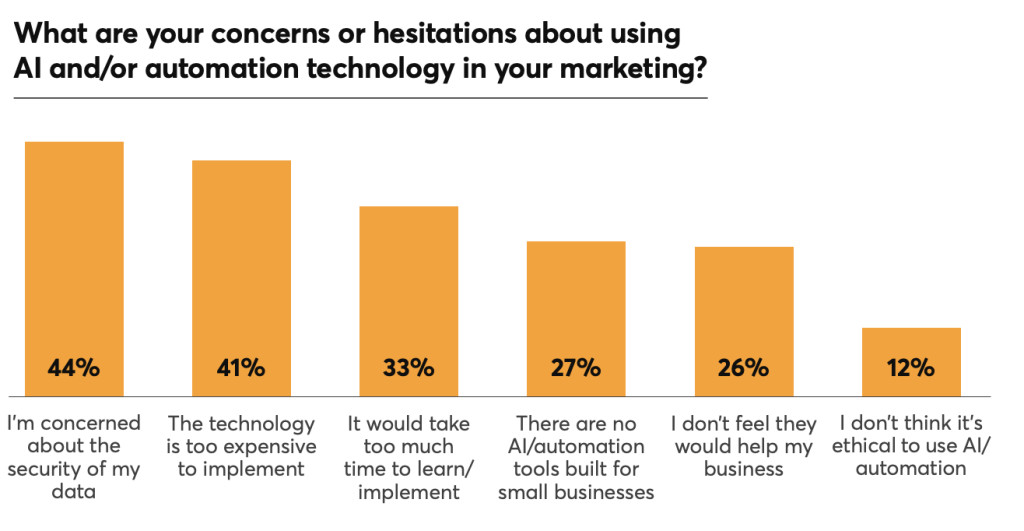
SMBs should stay informed about AI ethics and regulations in their industry. Develop clear AI governance policies, ensure transparency in AI decision-making processes, and regularly audit AI systems for potential biases.
While the challenges of implementing AI for SMBs are significant, they are not insurmountable. By addressing these hurdles head-on and taking a strategic approach to AI adoption, SMBs can unlock new opportunities for growth, efficiency, and innovation.
Remember:
By embracing AI technologies thoughtfully and strategically, SMBs can level the playing field and compete effectively in an increasingly AI-driven business landscape.
At J. Arthur, we are deploying multiple custom AI solutions with enterprise Gemini & GPT API’s. If you need an AI
Is Paid Search A Good Fit For My Business?While there are still some remnants of the Wild West spirit evident in online marketing, it’s important to be realistic about what can be achieved in a given timeframe, especially when you’re considering entering competitive markets or competing with established brands.
Unfortunately, many businesses neglect to consider whether or not their organizations are prepared to support a paid search program before jumping in and spending a lot of money. Paid search campaigns can deliver strong results, in fact PPC has an average of 200% return on investment (ROI)!
However, it’s important to understand when and why it may not be right for every business or every situation. Let’s take a look at several factors that help to determine whether a paid search campaign is worthwhile for your business.

Paid Search campaigns typically don’t take too long to set up (the planning necessary to run a solid campaign often takes more time than the actual setup.) Essentially, you can have an ad up for your website on the first page of the main search engines within an hour of campaign set up and activation. This is a great option for brand new websites that have little to no exposure in the search engines. The immediate nature of PPC is also beneficial for seasonal businesses.
“PPC ads boost a business brand awareness on average by 80%.” (HubSpot)
Organic SEO campaigns can take some time to produce results, as you train Google to view your site as an authority in your industry. This doesn’t mean that you should sit around with your feet kicked back, waiting for the organic results to kick in.
With a paid search campaign, you can gain top visibility almost immediately. When it’s setup properly, you can draw in instant leads, sales and revenue for your business (as long as you have the budget to compete). Then, when your organic visibility improves due to the search engine optimization work, you will have a strong standing in both areas.
Consider this: when a searcher sees a business in both the organic and paid real estate on Google, it offers the impression that the business is relevant.
Google Adwords allows users to target specific keywords and search terms. From there, you can analyze your data and work to identify the keywords that produce the highest conversion rates. This information is helpful for informing your SEO efforts as well: if a specific keyword is producing strong results through paid search then it would be beneficial to attempt to rank your website for the term organically as well.
Beyond this, you can also take the data from your Adwords campaign and Google Analytics account to analyze the conversion path your traffic takes. This undoubtedly helps to improve your funnel and identify areas that can be improved to increase your overall conversion rates.
When you search for a product or service online— let’s say an auto mechanic in your area, for example— you generally know what to type into the search engine to receive the results you’re looking for. You know what you need, and your audience does too.
So, what does this mean for paid search ads? If consumers already know what they want, and your ads and keywords align with their search, they’re likely to read and click on your ads to learn more about your products, services, or promotions.
This is effective, considering that it avoids resorting to high-pressure sales tactics, cold calls or “selling” the customer on what you have to offer. Rather, it offers the consumer the ability to make an informed decision.
If your business depends on lead generation and doesn’t have a back-end nurturing and closing funnel in place, then a paid search campaign may not be a good fit. Businesses that delve into paid search without solidifying their sales funnel are much more likely to fail. Having a tried-and-true process for working and closing leads will ultimately deliver more successful outcomes in terms of revenue and profit.
If you have an existing Paid Search account but have no idea what you want to accomplish, you’re not setting your business up for success. You’re facing an uphill battle if you expect your account to succeed without clearly defined goals and objectives. If you’re spending money on advertising, someone better have a clear answer of what the goals are and should be able to show the metrics that prove whether or not you’re on track to meet those goals.
If it’s unlikely that you will find interest in discussing your paid search goals, supporting metrics, and KPIs, paid search isn’t a good fit, as it requires clear established goals and a solid system to measure whether those goals are being achieved.
“72% of companies haven’t looked at their ad campaigns in over a month.” (Webfx)
Paid Search without measurement is a fruitless endeavor.
Contrary to popular belief, you can’t just hire a college student to plug in data and monitor the account. A successful paid search campaign demands skill, an informed strategy, a thorough understanding of the advertising platforms, a nuanced understanding of rules and guidelines, and a little creativity. If you aren’t willing to seek out professional help, your chances for success are limited.
On the other hand, it’s not helpful to hand over all of your efforts to a Paid Search professional and never look back. True successful paid search strategy comes with collaboration. Think of it this way: you are the expert spokesperson for your business and your Paid Search account manager is an expert in their field. Together you can collaborate and forge great strategies and ways to execute on any goals you may have for your business, products and services. Two heads are better than one.
So, when would a Paid Search campaign be worthwhile for your business? You should test a Paid search campaign out for your business if:
“PPC traffic converts 50% better than organic site visitors.” (Webfx)
J. Arthur | Paid Search Management
Ultimately, placing one tactic above the other with the use of grand statements is ridiculous and often detrimental to your efforts. We manage both paid and organic search optimization, allowing us to freely tout the benefits of both and talk realistically about the challenges and concerns in equal measure. It’s important to stay open-minded, think critically, and work to understand the nuances of both paid and organic search.
5 Social Media Mistakes That Sabotage EngagementLegions of people from all walks of life are spending more time on social media, as the line between the news feed and daily life becomes increasingly blurred. This is good news for businesses with hopes of improving engagement with potential customers.
After all, increasing social media engagement directly improves the chances of your content showing up in people’s news feeds. According to Statista, in 2024 the total number of social media users is projected to be 5.17 billion people! Every year, this number grows by about 300 million users per year. If your SMB isn’t utilizing social, there’s a lot of missed opportunities to be had.

It’s unfair to expect people to follow along and engage with your company’s page if you are posting inconsistently. Social media news feeds are constantly stocked with new and engaging content, so sparse publishing will make it easier for people to forget you. On the other hand, posting too much can end up painting your brand as annoying. In other words, social media publishing is a balancing act.
Your end goal should be to find a happy medium where you can consistently craft useful content that engages followers. Try releasing posts during times of the day that garner the most attention— consider when your ideal customer is most likely to be online. Take some time each week to look at your analytics and try to find a common pattern. Once you have honed in on a good timeframe, create a schedule for consistent posting.
It’s helpful to have a few non-time-sensitive posts on reserve, for the times when you need to work more on developing killer content— this way you won’t have to sacrifice quality during a time crunch.
HubSpot offers a great scheduling tool that allows you to pre-plan your social media posts, setting a schedule for consistent distribution. The average person spends about 145 minutes on social media every day, it’s a safe bet you’ll reach your audience at some point! (Forbes)
Whether it’s an individual or a business, everyone seeks attention for their latest post— without rabid eyes to soak up your content, what’s the point?
Yet, once again there is a balancing act between being captivating and being desperate. In other words, your quest to establish a brand image should not cross any boundaries that could potentially damage your business’s image— don’t ask for action on something completely out of line with your industry. So yes, that means you shouldn’t farm for likes by manipulating people’s emotions. If you are aiming for a post that appeals to the user’s emotions, be sure it directly relates to your business.
Social media users have become more savvy each year and they can smell desperation like a basset-hound.
Although it’s important to elicit responses from fans, you should avoid long-winded political rants, bad mouthing competitors, or posting overtly offensive content. We get it: it’s the age of outrage, but consumers don’t care how “edgy” you are. If you want to spur engagement, spark a light-hearted debate to get your fans talking, but be sure to stick to friendly, positive content. What you do on your personal account is your own business— if you want to be an edge lord, that’s your opportunity.
Commonly, businesses get over-enthusiastic when it’s time to ramp up a new campaign. While you should shoot for the stars, this doesn’t mean that you need to distribute your content on every popular platform. There’s a time and place for everything, including how to best reach your target audience.
Many companies create accounts and build business pages, neglecting to consider the difference between social networks. It may seem obvious, but Twitter is not LinkedIn; and Facebook is not Instagram.
There’s an implied design for successful posting on each platform— they have specific rules and don’t necessarily fit your brand identity and marketing purposes. Don’t try to be on every social network unless you have the content and time to craft posts that are worthwhile.
“Most marketers’ social network preferences vary depending on the type of businesses they work with. About 94% of B2C marketers prefer Facebook, and about 94% of B2B marketers prefer LinkedIn.” (AgoraPulse)
One day your company sounds like a Supreme Court Judge, the next your posts are littered with friendly slang. While some might find this a refreshing change of pace, many people might view your company as inconsistent and an unreliable source of credible information.
It’s in your best interest to agree upon a company-wide style philosophy that will serve as the foundation for all future posts regardless of who does the posting. Simply, you and your social media team need to agree on a tone that will influence all posts, regardless of the writer/poster.
Does your social media marketing strategy consistently fall short of your organizational goals? Knowing the answer to that is half the battle. If it’s time to rethink your strategy, all is not lost. Do research on what others in your industry are doing in social media: what works, what doesn’t and their tone. Take the time to get to know what type of content your potential clients, customers, and community want to see from you.
We understand that social media can be overwhelming, and it’s not always easy to change with each update or refresh. If you are looking to boost your social media marketing, then you may want to take a step back and reevaluate the online presence you already have.
Why TikTok is Your Business’s Next Big Marketing MoveIn 2024, TikTok has evolved from a trendsetting app into a vital business tool, thanks to TikTok Shop. This integrated marketplace has revolutionized the way companies engage with customers, offering a direct line from content to purchase. It’s where creativity in marketing thrives, allowing even the most traditional businesses to connect with audiences.
What’s more, TikTok users are demonstrating a remarkable openness to advertising. According to the latest Statista report (2023), “38% of survey participants using TikTok are willing to tolerate advertising in exchange for free access to certain services.” This suggests that TikTok users may be more receptive to your marketing efforts compared to users on other platforms.
TikTok’s vast and varied user base stands ready for businesses to tap into, from millennials to more mature demographics. The Social Shepherd highlights the platform’s engagement, noting, “With social media apps available right at our fingertips, it should come as no surprise that we access them multiple times in one day, oftentimes never giving it a second thought. Data shows the average user opens the TikTok app 19 times per day.” This frequency of use offers businesses repeated opportunities to connect with their audience.
Influencers on TikTok are redefining what it means to have brand ambassadors, offering reach and relatability. Interestingly, “almost 15% of TikTok users struggle to distinguish between advertising and other content,” suggesting that subtle, well-integrated marketing can be especially effective on this platform (Source).
TikTok is more than a social network; it’s a smart, strategic choice for businesses aiming to make their mark.
Let’s explore how TikTok can set your business on a new path in 2024.
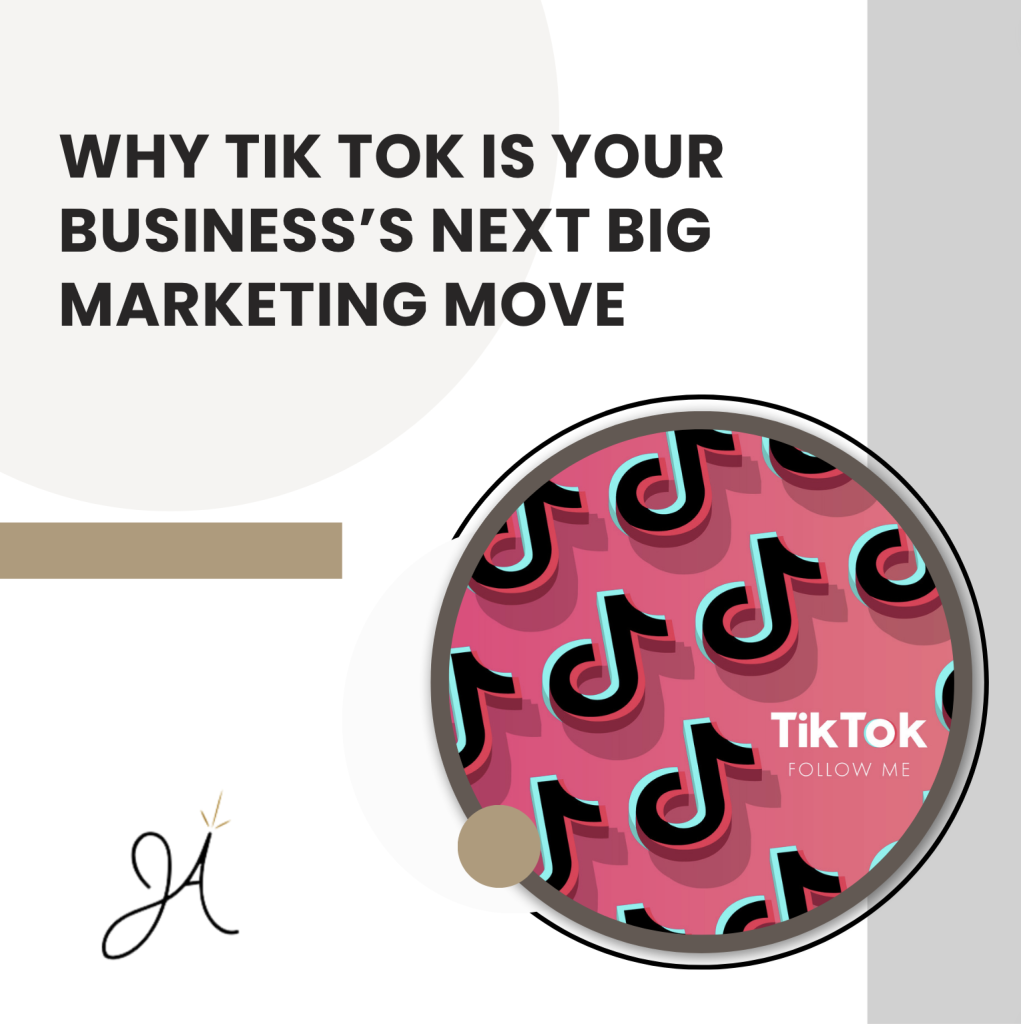
This dedicated shopping experience is a core piece of the app, offering businesses a streamlined path to convert views into sales. Users can move from discovery to purchase without ever leaving the app. That’s the seamless shopping experience TikTok Shop offers.
Moreover, TikTok Shop isn’t just a marketplace; it’s well suited for diverse promotional strategies and collaborations with creators who can amplify your brand’s presence.
TikTok thrives on the light-hearted, imaginative, and downright fun. It’s a space where authenticity meets creativity, a perfect blend for many businesses. Engaging on TikTok allows you to humanize your brand, creating a connection with your audience that’s built on genuine interaction and relatable content.
This platform is your canvas for crafting content that resonates, whether it’s through educational insights or a peek into your brand’s lighter side. By leveraging the app’s creative potential, you can elevate your brand’s narrative and carve out a space in the minds—and hearts—of your audience.
Since its launch in 2016, TikTok has shattered download records, surpassing long-standing social platforms. It’s a melting pot of global audiences, transcending the stereotype that it’s just a teenage playground.
The diversity of TikTok’s user base is a testament to its universal appeal. With a significant portion of users across various demographics, TikTok offers businesses a chance to tap into a wide-ranging audience, including those influential millennials and Gen Zers.
Viral fame on the app isn’t just for the lucky few; it’s an open playing field where anyone has the opportunity to skyrocket to success quickly. The app is packed with influencers across every conceivable niche, providing businesses with a vast array of partnership opportunities to target specific markets with precision.
Navigating the influencer arena is made simpler with TikTok’s Creator Marketplace. This analytics tool is a compass for brands, guiding you to the influencers who align with your values and objectives, complete with data-driven insights into their reach and engagement.
TikTok’s succinct video format is not only digestible; it’s versatile. These bite-sized videos can leap off the TikTok platform and land directly into your email campaigns, website, or other social channels, igniting curiosity and enhancing engagement across all your touchpoints.
However, brand consistency is key. Ensure your content complements your overall messaging, maintaining a cohesive brand experience no matter where your audience encounters you.
For many businesses, diving into advertising may seem daunting, but the platform’s budget-friendly nature makes it an accessible avenue for brands of all sizes. You can start small and scale your investment as your familiarity and success with the platform grow.
Embracing TikTok for business is a savvy move in 2024. With minimal investment, you can unlock significant organic reach and engagement, making TikTok not just a smart choice, but a strategic one for businesses looking to make a mark.
Digital Marketing in 2024: The 10 Essential Trends to WatchA successful digital marketing strategy is not just about adopting the latest tools and trends; it’s about understanding the evolving behaviors and expectations of your customers.
From the nuanced evolution of voice search optimization and the strategic application of chatbots, to the creative opportunities opened by video marketing and the personalized touch of advanced AI, the year ahead offers a variety of opportunities for businesses to connect with their audience on a deeper level.
Let’s review the ten latest digital marketing trends that offer a blueprint for a solid strategy in 2024. These new tactics will challenge your business to listen more intently, respond more intelligently, and craft experiences with precision and purpose.
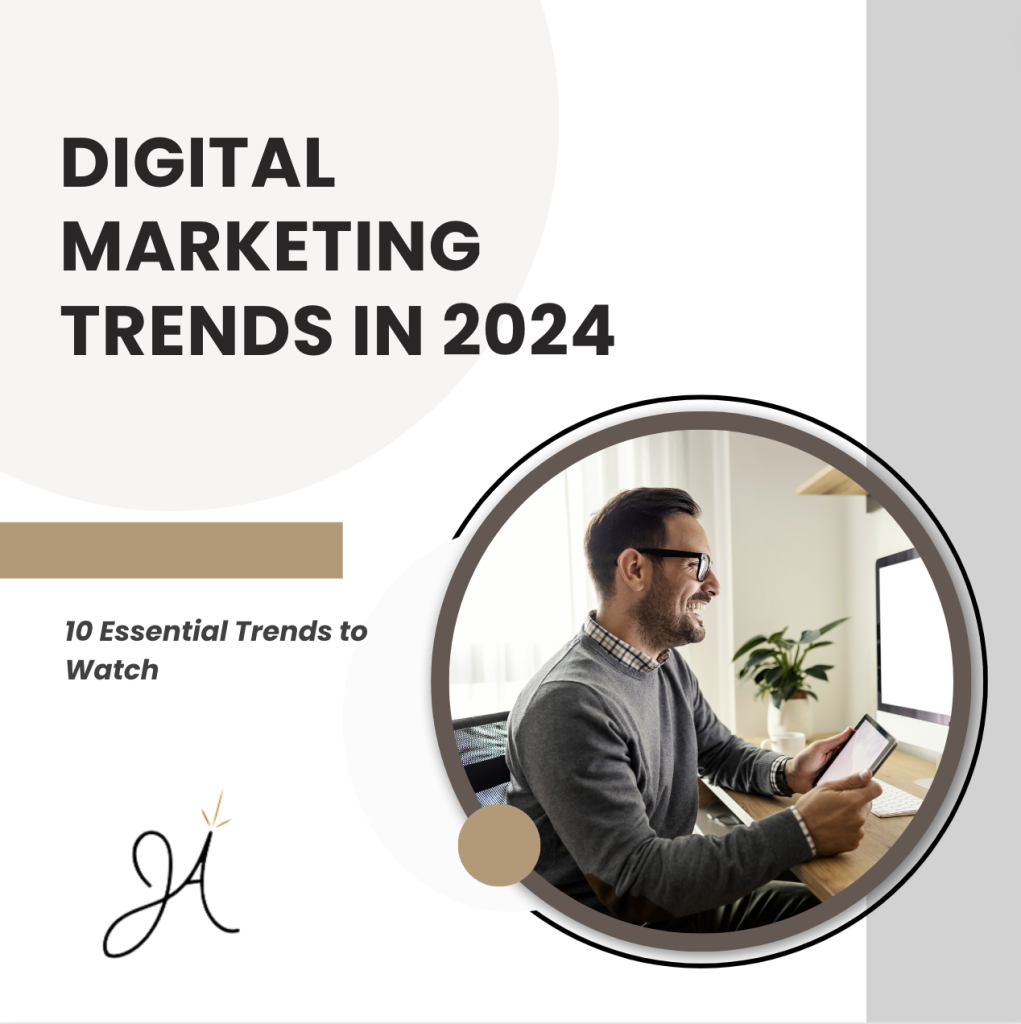
Top 10 Digital Marketing Trends Shaping 2024
Voice search is quickly becoming more common in consumer habits, with people showing a growing preference for the convenience of vocal commands over traditional typing. This evolution in search behavior has considerable implications for SEO strategies:
Adapting to voice search isn’t just about staying current; it’s about meeting customers in their moment of need with the right information at the tip of their tongue.
“There are over 2.35 billion Instagram MAUs (Monthly Active Users), and it is projected that the number will rise to 2.5 billion by 2024.” (Demand Sage)
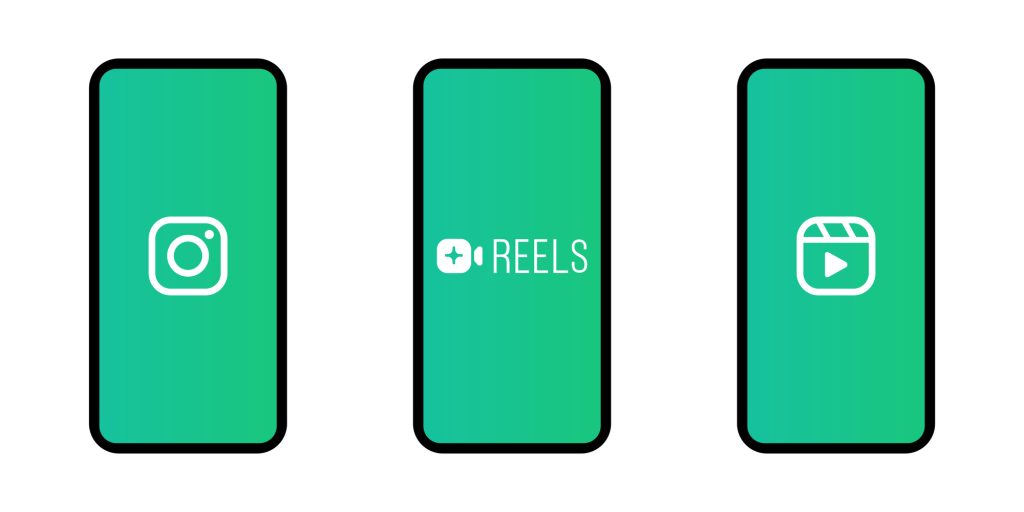
The fleeting nature of social media reels has captured the attention of users seeking authentic content, and in 2024, their influence is stronger than ever:
A study by Hootsuite highlights that 64% of marketers have either already incorporated Instagram Stories or reels into their strategies or plan to. With the format’s growing popularity, it’s a trend that savvy marketers cannot afford to overlook.
Personalization has become increasingly useful, with customers expecting interactions tailored specifically to them. Utilizing data analytics, you can now craft individualized experiences that resonate on a personal level. This approach not only enhances customer satisfaction but also significantly boosts conversion rates. As personalization technologies become more accessible, they will be crucial for businesses looking to differentiate themselves and cultivate loyal customer relationships in 2024.
68% of users enjoy the convenience that comes with using chatbots, in particular how quickly they receive a response.(UserLike)
Chatbots are evolving from simple scripted responders to sophisticated AI-powered assistants capable of handling complex customer service interactions. Here’s how this trend is unfolding:
Businesses adopting advanced chatbots will find themselves at an advantage, providing exceptional customer experiences that can significantly enhance brand perception and loyalty.
Video marketing remains a compelling tool to engage and convert audiences. Its continued dominance is driven by:
Influencer marketing is set to maintain its stronghold as a key strategy for connecting with audiences, particularly among younger demographics. By partnering with influencers whose followers align with their target market, brands can foster trust and authenticity in a way that traditional advertising cannot match. This trust translates into tangible results, as recommendations from influencers continue to be a powerful driver of consumer decisions. As the influencer landscape grows, so too does the opportunity for brands to leverage these partnerships for impactful marketing campaigns.
Augmented reality (AR) is not just a game-changer; it’s reality redefined. In 2024, we see it playing a crucial role in how brands interact with consumers:

“Around 4 in 5 companies deem AI to be a top priority in their business strategy.” (Forbes)
Artificial Intelligence (AI) offers unparalleled insights and automation capabilities:
According to Salesforce, 84% of marketers report using AI in their strategies, underscoring the growing reliance on AI to drive marketing innovations.
Interactive content is setting the stage for a more engaged and participatory experience between brands and their audiences. Quizzes, polls, and interactive infographics invite users to become active participants in the storytelling process, fostering a deeper connection and understanding.
This type of content not only enhances user engagement but also provides valuable insights into consumer preferences and behaviors, enabling brands to tailor their offerings and communications more effectively.
As digital consumers become increasingly accustomed to a dynamic online experience, interactive content emerges as a key differentiator in capturing and maintaining audience attention.
63% of Internet users believe most companies aren’t transparent about how their data is used, and 48% have stopped shopping with a company because of privacy concerns. (Tableau)
With consumers becoming more aware of and concerned about their online privacy, transparency, and data protection are moving to the forefront of digital marketing strategies. The implementation of GDPR in Europe and similar regulations in other regions has set new standards for data handling and consumer rights.
Brands that prioritize and communicate their commitment to data privacy can build trust and loyalty among their customers. This trend is driving marketers to adopt privacy-focused approaches, ensuring that personalization and data-driven strategies are balanced with respect for user privacy.
Effective digital marketing in 2024 recognizes the importance of privacy as a value proposition, aligning marketing practices with consumer expectations for security and transparency.
Embrace Change & Evolve Your Digital Strategy in 2024
As we look towards the future, one thing is clear: the brands that succeed will be those that are not only quick to adapt to new technologies, but also committed to using these tools to foster more meaningful, transparent, and respectful interactions with their customers.
2024 is a year to embrace change and to boldly step into the future with a strategy that is both innovative and grounded in the values of your customers.
What once worked for your SMB even five years ago may not be effective in our current landscape.
Most small-to-medium sized businesses don’t know where to start with revamping their marketing efforts. Or they find they don’t have time to truly give their marketing strategy the attention it deserves.
We understand. Embracing these trends with the help of seasoned experts like J. Arthur can transform challenges into opportunities, setting your brand on a path to not just navigate but thrive in the New Year!
Why Paid Search Should Be Your Go-To Digital Strategy in 2024As we step into 2024, businesses are continuing to adapt to the ever-evolving digital landscape. In an effort to stay ahead of the competition, Pay-Per-Click (PPC) advertising emerges as an incredible opportunity for businesses of all sizes. But why should paid search be your go-to strategy this year? Let’s delve deeper into the world of paid search and discover how it can transform your digital marketing efforts.
One of the most compelling reasons to adopt PPC is its remarkable ability to convert viewers into customers. Statistics reveal that PPC traffic converts 50% better than organic site visitors. This isn’t just about increasing traffic; it’s about attracting the right kind of traffic – the kind that leads to real, measurable conversions. In an environment where every click counts, directing the right audience to your site is crucial for success.

While SEO remains a crucial part of a comprehensive digital marketing strategy, PPC has the potential to bring in double the number of website visitors compared to SEO. This immediate impact is particularly beneficial in today’s fast-paced market, where businesses need quick and adaptable strategies. PPC campaigns offer flexibility and immediacy, allowing businesses to respond to market trends and customer behavior in real-time.
A significant advantage of paid search advertising is its impact on brand awareness. Studies, including one by Hubspot, suggest that PPC can boost brand awareness by as much as 80%. PPC campaigns are not just about reaching audiences; they’re about creating meaningful connections with potential customers. This makes PPC an invaluable tool for building brand recognition and establishing a presence in your industry.
The digital marketing climate is often at the mercy of search engine algorithm updates, particularly with SEO. However, PPC stands resilient against these changes. With a paid search campaign, you have a consistent and reliable strategy that is not directly impacted by these updates, providing stability in your marketing efforts.
In 2024, PPC is not just a strategy for generating clicks; it’s a pathway to achieving business growth and success. Here are some ways paid search can change your digital marketing this year:
So, when would a Paid Search campaign be worthwhile for your business? You should test a Paid search campaign out for your business if:
As digital marketing campaigns become more complicated and time intensive, more companies are turning to professional paid search management companies for help. J. Arthur provides the most skilled PPC management professionals in the industry. With decades of combined experience, our staff analyzes your marketing goals, provides the best strategy in the market, and then implements a proprietary real-time bidding algorithm for unsurpassed 24/7 monitoring.
This proprietary tool allows us to manage the ever-changing bids for the top paid search engine rankings. This means we can protect your position and make sure you are paying the lowest possible price. Always.
Maximizing E-Commerce Sales During the Holiday Season: J Arthur’s Proven Strategies
The holiday season, a pivotal time for e-commerce businesses, brings a wave of opportunities and challenges. This period marks a short but critical window that significantly impacts annual sales outcomes. In a competitive digital marketplace where over half of all e-commerce sales are made on mobile devices, a robust digital marketing strategy becomes invaluable.
J Arthur has consistently been at the forefront of this digital revolution, crafting innovative strategies that not only engage audiences but also drive substantial sales growth and impressive ROAS (return on ad spend). Here’s an insight into our approach.
During this year’s holiday shopping frenzy, our team executed strategies for three dynamic e-commerce clients: Run Newport, Tool Authority, and Xelero Shoes. Each faced the challenge of making a mark in the crowded 2023 Black Friday and holiday season. Our comprehensive strategy, integrating tailored SEO, impactful social media engagement, and targeted paid search campaigns, led to a significant uptick in sales, breaking their previous records for November.
Let’s delve into the distinct marketing strategies that fueled their success!
Run Newport focuses on offering a range of quality, comfortable products. The holiday challenge was to effectively communicate their ethos of comfort and community to a broader audience, distinguishing them from more traditional stores in the high-stakes Black Friday time period.
The challenge for Tool Authority was to make a mark in the highly competitive Google Shopping space. The goal was twofold: amplify visibility and convert the increased traffic into sales, amidst a barrage of competing offers and aggressive advertising tactics.
Xelero Shoes had the dual task of making their presence felt across various marketing channels during the busiest shopping season. Their unique selling point of combining comfort with innovation needed to be effectively communicated through their Black Friday deals across paid search, social media, and email marketing efforts.
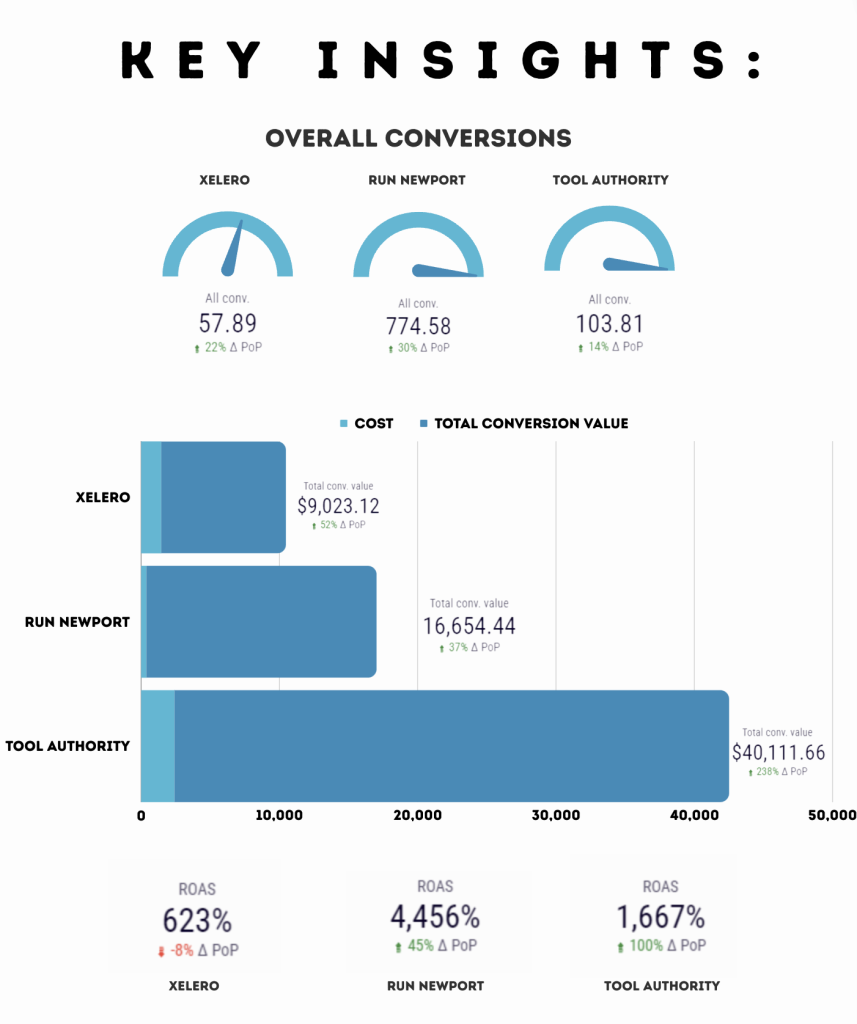
For Run Newport, our strategy was personalized, highlighting their commitment to quality and comfort through carefully targeted Black Friday ads. We utilized storytelling to resonate with their audience, ensuring the brand’s dedication to exceptional customer service and trendy offerings was well communicated.
For Tool Authority, a robust and strategic increase in their Google Shopping budget was key. Our campaigns were designed to showcase unique offers, ensuring Tool Authority was a top consideration for shoppers during their holiday purchasing decisions.
Xelero Shoes required a comprehensive approach. Our finely-tuned paid search ads accentuated their Black Friday offerings, while our social media strategy added an interactive element, generating excitement around their products. The email campaign, equipped with enticing discount codes, not only drew high engagement but also effectively converted interest into sales.
For Run Newport, our Black Friday ads strategy paid off remarkably. The data shows a striking 30% increase in overall conversions and an impressive 37% rise in total conversion value compared to the previous period. The Return on Ad Spend (ROAS) surged by 45%, while the campaign costs were reduced by 5%, showcasing a highly efficient and effective marketing approach.
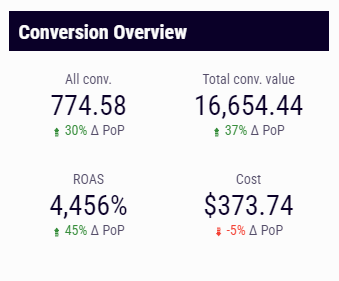
Tool Authority’s decision to increase their budget for Google Shopping campaigns during the holiday season brought significant returns. Their metrics reflect a solid 14% growth in overall conversions, accompanied by a remarkable 238% boost in total conversion value compared to the earlier period. These figures underscore the success of our targeted and aggressive strategy in the competitive online shopping landscape.
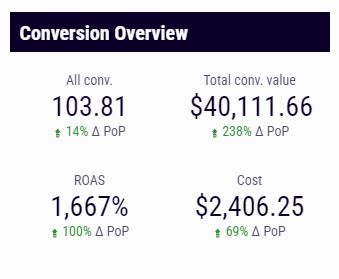
Xelero Shoes’ multi-channel marketing campaign, encompassing paid search, social media, and email marketing, culminated in impressive results. The campaign led to a 22% increase in overall conversions and an astonishing 52% surge in total conversion value. This outcome highlights the effectiveness of our comprehensive and coordinated approach across multiple marketing channels.
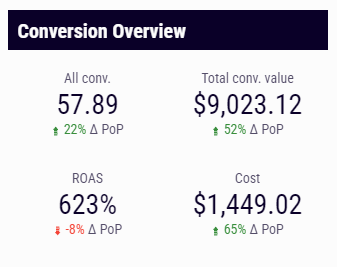
The holiday achievements of Run Newport, Tool Authority, and Xelero Shoes were the result of strategic planning, creative execution, and ongoing optimization by our team at J. Arthur. We believe in crafting customized campaigns that resonate with each client’s unique story and market. Our data-driven approach ensures that every decision maximizes the impact of the investment.
Ready to improve your digital marketing strategy for the upcoming year? If you’re seeking a significant improvement in your ROAS and tired of lackluster results, it’s time to explore new strategies with the experts at J. Arthur.
Join the ranks of successful businesses by revamping your digital strategy and partnering with us for exceptional results. Let’s set the stage for a prosperous 2024, smashing sales targets and redefining digital marketing excellence!
To discover how J. Arthur can amplify your e-commerce marketing, schedule a consultation today.